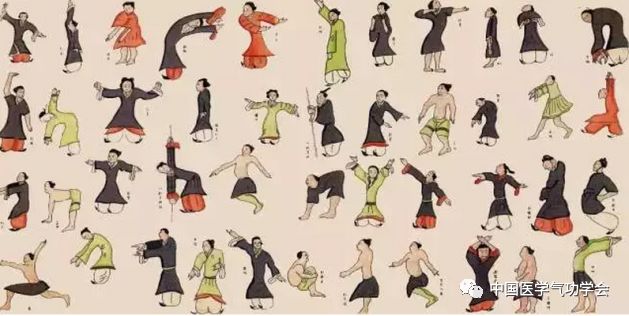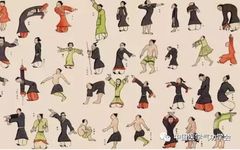
Understanding Daoyin: Insights from the Daoyin Diagram


In the history of Qigong, there are several diagrams referred to as “Daoyin Tu”. The “Daoyin Tu” mentioned here refers to a precious artifact unearthed from the Mawangdui Han Tomb No. 3 in Changsha, Hunan, in 1974. This artifact measures approximately 100 centimeters in length and 40 centimeters in height. The original diagram was found without an author’s signature, inscription, or title, and since the entire diagram depicts Daoyin movements, researchers named it the “Daoyin Diagram”. The diagram is divided into four rows, illustrating over 40 Daoyin images, some of which are accompanied by text related to movements, breathing, and healing, while others depict the use of instruments. It is generally believed that this diagram is the earliest existing Qigong Daoyin diagram. So, what is Daoyin, and what are its functions? Here, I will discuss the past and present of Daoyin in conjunction with the “Daoyin Diagram”.

The character “导” (dao) in “Daoyin” was historically written as “導”, resembling the character for “道” (dao) in form and meaning. Therefore, ancient texts sometimes refer to “Daoyin” as “導引” or “道引”. Preliminary research suggests that the term “Daoyin” may have originated from the Daoist classic text “Zhuangzi”, where it states: “Blowing and breathing, expelling the old and taking in the new, imitating the bear and the bird, is merely for longevity. This is the way of the Daoyin practitioners, who cultivate their forms, favored by Pengzu, the immortal known for longevity.” The general meaning is that adjusting one’s breath and mimicking the movements of animals like bears and birds are effective methods for health and longevity, favored by those who practice Daoyin and body cultivation. A review of ancient and modern Qigong and health literature reveals that the term Daoyin encompasses at least three meanings: first, it refers to all Qigong practices, including dynamic and static forms. For instance, during the Jin Dynasty, Li Yi commented on “Daoyin” in “Zhuangzi”, stating that Daoyin is “guiding Qi to harmonize and leading the body to soften”. Although he did not directly define Daoyin, he summarized its function, believing that Daoyin harmonizes the internal Qi and softens the external body, which are indeed the functions of Qigong, a view supported by many later scholars. In the Tang Dynasty, Cheng Xuanying echoed this in his commentary on the “Nanhua Zhenjing”: “Blowing cold breath and expelling the old, inhaling warm breath and taking in the new, like a bear climbing a tree and a bird flying in the sky. These are all Daoyin practices to nourish the spirit and body, prolong life, and maintain physical form.” Contemporary scholar Guo Moruo stated more directly in his book “The Era of Slavery”: “The Daoyin referred to by the ancients is what we now call Qigong.” Second, it specifically refers to the dynamic forms within Qigong. In the “Records of the Three Kingdoms: Biography of Hua Tuo”, it is said through Hua Tuo: “Thus, the immortals of ancient times engaged in Daoyin practices, imitating the bear’s neck and the bird’s stretch, moving the joints to seek to delay aging.” This implies that ancient health practitioners used movements similar to those of bears and birds to bend and stretch their bodies and joints to slow down aging. Many ancient scholars supported this view, such as Yang Shangshan during the Sui Dynasty, who noted in his commentary on the “Huangdi Neijing Taisu: Legacy Text” that “Daoyin refers to the Five Animal Frolics like the bear’s neck and bird’s stretch”; and Wang Bing during the Tang Dynasty, who stated in his commentary on the “Huangdi Neijing Suwen” that “Daoyin refers to shaking the muscles and bones, moving the limbs and joints”. The Tang monk Huilin also included self-massage in the narrow definition of Daoyin, stating: “Any person who massages and kneads themselves, stretching their hands and feet, relieving fatigue and worries, is called Daoyin.” Third, it refers to guiding Qi and circulating Qi. For example, in “Mr. Ning’s Daoyin and Qi Cultivation Method”, it states: “At the site of the ailment, guide Qi to expel it with intention.” Additionally, some have referred to movements directed by external Qi as Daoyin. From the various perspectives, we can see that Daoyin has both broad and narrow meanings: broadly, it includes all Qigong practices, both dynamic and static; narrowly, it refers only to the dynamic forms within Qigong, including self-massage.
Clearly, the “Daoyin” depicted in the “Daoyin Diagram” belongs to the narrow definition of Daoyin—dynamic Qigong. The restored “Daoyin Diagram” presents over 40 line drawings showcasing the vivid practice scenes of ancient practitioners, with 4 rows of Daoyin figures, each row containing 11 images, each image measuring between 9 and 12 centimeters in height. Among them, 5 images are equipped with instruments such as plates, sticks, balls, and bags, commonly referred to in the Qigong community as instrument-assisted Daoyin; 28 images are accompanied by rich textual annotations, which relate to breathing (e.g., “卬謼” and “爰謼”), essential movement techniques (e.g., “蠪蹬”, “鹞北”, and “熊经”, which mimic animal activities), or healing (e.g., “引聋”, “引贵”, “引温病”, “引脾痛”, “引厀痛”, “引炅热”, “引胠责”, etc.). Thus, experts speculate that the “Daoyin Diagram” illustrates both the methods of Daoyin (unarmed Daoyin, breathing Daoyin, biomimetic Daoyin, and instrument-assisted Daoyin) and its therapeutic effects. To promote the health preservation and disease prevention methods depicted in the “Daoyin Diagram”, the National Sports Administration’s Fitness Qigong Management Center has organized experts to compile and adapt two sets of practices based on the “Daoyin Diagram”: “Fitness Qigong: Mawangdui Daoyin Technique” and “Fitness Qigong: Taiji Health Stick”, which have received positive feedback from fitness Qigong enthusiasts.
As the saying goes—
Unearthed artifacts of the Daoyin Diagram, a selection of dynamic practices from the pre-Qin era;
Various movements with diverse types, annotated with essential techniques and effects.


